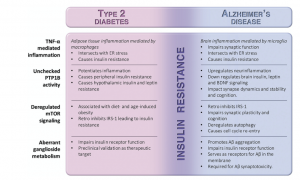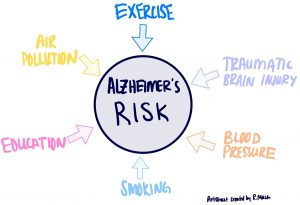Alzheimer’s: the complicated disease resulting in memory loss, confusion, and disorientation. Odds are we’ve all heard of this disease and the profound implications it can have on people’s lives, but there may be much more to this issue than we have previously understood.
In the brain:
In Alzheimer’s, there are obviously many things going wrong in the brain, leading to the complex nature of the disease. However, the cause of Alzheimer’s can really be boiled down to one main issue: insulin resistance. Insulin is crucial to the brain’s normal functioning, so issues with it working properly have detrimental results. There are essentially four facets that lead to the insulin resistance seen in Alzheimer’s. These are: inflammation, unchecked PTP1B activity, deregulated mTOR signaling, and abnormal ganglioside metabolism.
The first part of the insulin resistance understanding of Alzheimer’s is inflammation. Inflammation in the brain is known to cause insulin resistance, considering it impairs synaptic functioning and goes hand-in-hand with stress on the endoplasmic reticulum. Next is unchecked PTP1B activity. PTP1B is an enzyme that is an important regulator of the insulin signaling pathway. It is a negative regulator, which is important when working properly, but when unchecked, causes insulin resistance. The third facet of insulin resistance comes from deregulated mTOR signaling. The mTOR signaling pathway is an important regulator of cell metabolism, proliferation, and survival. When mTOR signaling is off, it retroactively inhibits insulin substrates so that they are no longer able to bind to their receptor. This once again leads to the insulin resistance seen in Alzheimer’s. Finally, ganglioside metabolism is abnormal in Alzheimer’s. These gangliosides, specific molecules containing a glycosphingolipid and one or more acids, promote the aggregation of amyloid-beta protein plaques that run wild in Alzheimer’s.
With all of the previous implications considered, we can see that insulin resistance is an important contributor to Alzheimer’s and may be a significant system to target when thinking about future treatments and therapies. What’s also quite fascinating is that all four of those causes are also linked to the insulin resistance seen in type 2 diabetes. Many of us likely did not know that type 2 diabetes and Alzheimer’s are so interconnected in causes and mechanisms. Here is a figure that summarizes these concepts:

Outside the brain:
Now that we’ve taken a look at what exactly is contributing to Alzheimer’s within the brain, it’s also important to keep in mind the factors that come from outside the brain and body: from the environment.
The most important risk factor for Alzheimer’s is increasing age (which many of us might have guessed!) but other environmental risk factors are not well understood, though they are quite prevalent. One study suggests that half of the individual differences seen in Alzheimer’s risk levels may be environmental. In other words, half of any one person’s chances to develop this disease could be attributed to environmental causes, which is insane! Obviously with findings this significant, there needs to be a better understanding of environmental factors in Alzheimer’s. It is crucial to understand the full Alzheimer’s exposome, which is another word for the complex gene-environment interactions that lead to individuals’ higher or lower susceptibility and onset of Alzheimer’s.

There are several environmental factors known to have a role in Alzheimer’s risk. Some main ones are exercise, traumatic brain injury, blood pressure, smoking, education, and air pollution. Interestingly, researchers have found that the onset of dementia was a decade earlier in individuals with these environmental risks. A whole decade! Obviously with environmental factors having this significant of a shift in the onset curve, we must begin to think about how our lifestyle shapes our life outcome.
We now see that Alzheimer’s is much more complex than originally understood. Considering insulin resistance, environmental factors, and link to type 2 diabetes, this disease deserves much more recognition and research so we can hopefully work towards a better understanding, and eventually, a cure.
